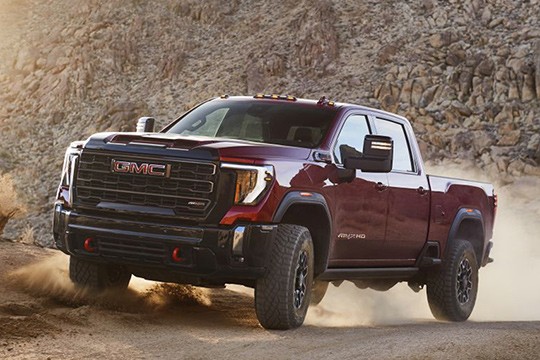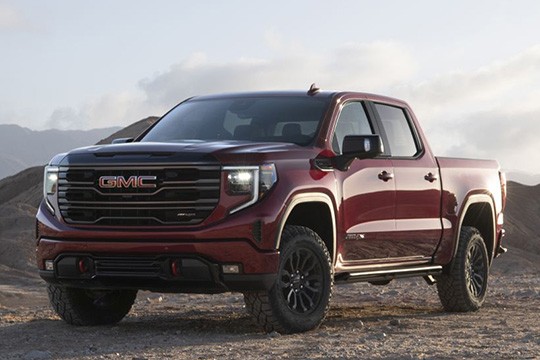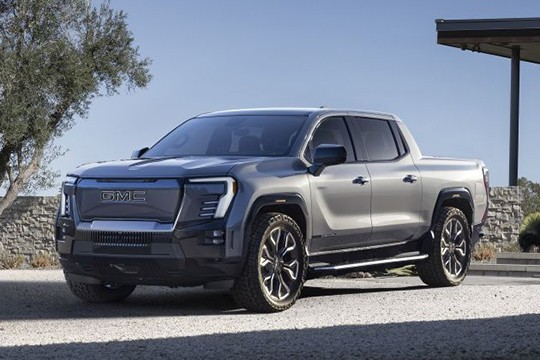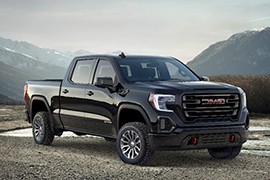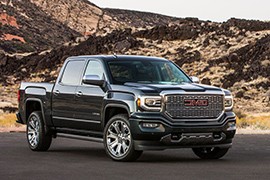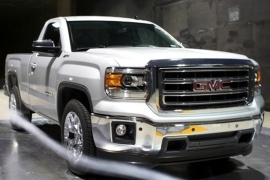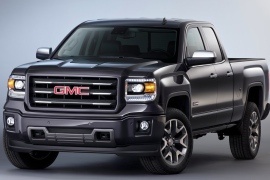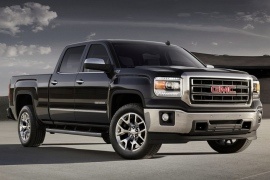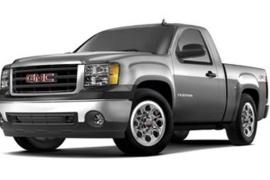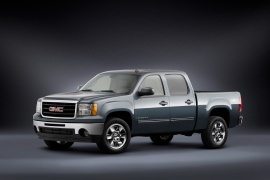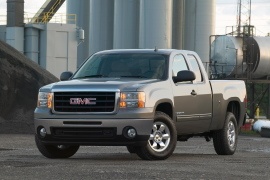GMC Sierra Models/Series Timeline, Specifications & Photos
First production year: 2007
Engines: Diesel, Gasoline, Electric, Ethanol, Hybrid
Body style: Truck
GMC has completed its off-road-oriented lineup of trucks with the introduction of the 2024 Sierra HD AT4X and its even more rugged sibling, the HD AT4X AEV.
Both versions were launched simultaneously in spring 2023, throwing the gauntlet toward what RAM and Ford already had on their offers. But GMC waited a little bit more, and the result was astonishing. The big rig was able to pull anything with wheels on it, and it could also provide comfort and a "get out of my way" appearance.
The GMC Sierra 2500 HD was already a big truck on the road, but it was mainly built for construction sites or to pull a heavy load on a trailer behind it. But the AT4X version came with an enhanced look that boasted a huge black grille up front, a black bumper, and two exposed red towing hooks. The headlights were carried over from its less-hardcore off-road sibling, the 2500 HD. From its side, the high ground clearance was noticeable, and so were the 35" MT tires mounted on the 18" alloy wheels. On its sides, to ease reaching out inside the bed, the automaker installed side steps on the rear quarter panels.
But all that rugged exterior look was hiding a wide and spacious cabin for five people. Boasting massaging front seats, a full-grain leather-wrapped interior, and a Bose sound system, it was the truck aimed for those ready to travel long distances toward their next camping location. The dashboard was fitted with a 13.4" touchscreen for the infotainment system and a 12.3" instrument panel in front of the driver.
Powering this behemoth truck was either a 6.6-liter gasoline engine or a same-displacement Duramax turbo-diesel powerplant.
After successfully introducing the AT4 version for the Sierra in 2018, GMC took another step and launched the AT4X version, which aimed higher than its cousin.
GMC looked determined to crush the F150 Raptor dominance in the segment, and that's why it tried to provide more than anything Ford had to offer. Thus, with the AT4X, the American automaker provided a vehicle that was above average not only in off-road abilities but also able to offer luxurious features that usually are not available for go-anywhere vehicles. But there's a reason why most carmakers don't offer that. Climbing back into the cabin with boots full of mud and dirty clothes due to the elements is something other than what drivers would like to do if that would damage the upholstery.
But being luxurious doesn't mean that only the interior has to be treated nicely. The car's exterior also went through an upgrade. The AT4X was available exclusively for the Crew Cab version, with either a short or a standard bed in the back. At the front, unlike the AT4, the X version featured a new grille with a brushed-bronze trim. Yet, the towing hooks were left red, just like on its non-X sibling. At the back, the tailgate had a separate folding part that opened to be used either as a step to ease access to the bed or as a bench where someone could sit and watch the fishing rod.
The interior was crafted with inspiration from the luxury car segment. Thus, the cross-stitching on the door cards and the leather upper sections looked like they were carried over from an Escalade. Furthermore, the wood trims below those areas spelled luxury everywhere. For a better driving experience, the AT4X featured a Bose sound system that took the concert hall into the woods. At the front, the occupants could enjoy the big, 13.4" wide touchscreen atop the center stack, while the driver was spoiled with a 12.3" instrument panel.
Under the hood, GMC installed as standard a 6.2-liter V8 gasoline engine paired with a ten-speed automatic transmission. Strangely, the AT4X was available with either an RWD or a 4x4 system.
GMC tried to offer something more than a regular work truck with the Sierra and created the Denali version, which was a crossover between a luxury car and a pickup truck.
The Sierra Denali was always a luxurious vehicle, but for the 2022 model year, the automaker threw everything it got in its parts bin and created a vehicle unrivaled on the market. Maybe it wasn't the most powerful or the biggest in the pickup world, but it boasted a high level of features and amenities that could attract buyers from the premium car segment.
GMC took the bodywork of a crew-cab Sierra and then added exclusive features to it. At the front, the C-shaped LED daytime running lights created a powerful image for the vehicle. The three-letter badge took center stage on the flat, broad grille that covered almost the entire area of the front fascia. From its profile, the 22" wheels, offered on the Ultimate trim level, confirmed that the vehicle was meant mostly to roam the roads, not the trails. At the back, the carbon-fiber composite bed was the largest in its class, with a total volume of 63.9 cu-ft (1,809 liters).
Inside, the driver was greeted by two large screens. In front of them was a 12.3" display for the instrument panel, and a second touchscreen was placed atop the center stack and featured built-in Google and Amazon Alexa. In addition, it was enhanced by a 12-speaker Bose sound system. As expected in any luxury vehicle, the leather-wrapped interior provided plenty of legroom and headroom for all passengers. Still, even though the rear bench was designed for two, it could accommodate three passengers.
Under the car's skin, the Sierra was still built on top of a chassis, and the only available engine was a 6.2-liter V8 that sent its power to a standard 10-speed automatic gearbox. Since it was more of a luxury vehicle than a workhorse, the Denali was available either with RWD or 4x4.
After the introduction of the Chevrolet Silverado EV, it was just a matter of time until GM launched the Sierra with an electric-powered version, and it did that in style in the Denali grade.
GM put a large amount of money into the Ultium electric platform that served as a base for the HUMMER EV and the Silverado, so it used it for more than one brand. Thus, after those two vehicles, it introduced the Sierra EV Denali as a luxury, all-electric pickup.
At first sight, it had already impressed with its LED-illuminated badge in the middle of the front fascia, which was covered by a wedged-shaped panel surrounded by the same kind of illumination. In the lower bumper, the automaker installed the main headlights and, below them, the fog lamps. Like the rest of the Sierra family, the LED C-shaped daytime running lights flanked the front fascia. From its profile, the 22” light-alloy wheels were specific for this vehicle. They were underlined by the piano-black cladding mounted on the wheel arches. Unlike most traditional pickups, the Sierra EV Denali, like its Silverado sibling, featured tilted-forward C-pillars at the back of the cabin. Its bed came in one size.
Inside, GMC confirmed the luxury-oriented Denali trim level. The Edition 1 version featured leather-wrapped seats and wood trims on the dashboard and door cards. In addition, the driver was spoiled with screens on the dashboard: an 11” one for the instrument cluster and a 16.8” one atop the center stack for the infotainment system. In the back, the Sierra EV Denali Edition 1 featured a mid-gate opening system that connected the cabin to the bed.
Since it was based on the Ultium platform, the electric pickup was powered by two motors and fed by a large battery pack that offered it a 400-mile (644 km) range.
GMC released the Sierra AT4 in 2018 as a leading competitor for the reigning Ford F150, but not any 150; the Raptor version.
The half-ton pickup-trucks were often used for off-roading situations, and the carmakers made them more and more capable of getting in the middle of nowhere and back without too much fuss. But in the end, it all comes to the ground clearance, tires, power, and traction. When any of these is gone, the others can't do anything. GMC tried to solve as many problems as possible, giving more power, more traction, and better ground clearance to the Sierra in the AT4 form.
The first noticeable difference between an AT4 and a regular Sierra was the height. With a 2" lift kit fitted as standard, the AT4 was taller and thus appeared more impressive on the road. At the front, the big headlights and the black grille dominated the roads ahead. Unlike its siblings, it featured two red tow-hooks at the front. On its sides, the plastic moldings inside the wheel-wells made the gap seems smaller, but it was tall enough to put a six-pack on the wheel without any trouble.
The interior was fit for an overnight stay if stranded in the woods. It was wide, spacious, and could fit up to five people, but only two could sleep well on the wide front seats, separated by a center console, wide enough to serve as a nightstand. GMC installed a color head-up display for the driver and a rear camera mirror.
GMC offered the Sierra AT4 with a standard 5.3-liter V8 engine, while a 6.2-liter V8 and a 3.0-liter turbo-diesel were offered as an option. For better traction, the carmaker installed a standard rear differential lock and a two-speed transfer case.
There was a time when pick-up trucks were just pick-up trucks, with no convenience features and a rudimentary interior design.
The GMC Sierra Denali is just an example of how things evolved along the time, being one of the most luxurious pick-up trucks on the market.
For 2019, the Denali featured lots of innovative features to provide maximum practicality and comfort.
The luxurious pick-up truck featured the most innovative tailgate in the automotive industry. The lower part of it came down and served as a step, the little step could also be used as a cargo stopped if folded up and the top half could be lowered and added to the step, turning into an increased cargo stopper. And this was no hard thing to do, the tailgate featuring 2 buttons for easy actioning.
At the front, the Denali was just massive, with a huge chrome grille and fog lights the size of a smaller car’s headlamp.
Inside, the Denali offered multiple storage spaces and even two separate gloveboxes. The interior mirror was highly functional, offering a much wider view of what was behind using the rear view camera instead the obstructed real image, and a car the size of a Denali was much easier to manoeuver.
All the controls were intuitively placed and easy to use, drivers could choose the preferred driving mode by switching between Tour, Sport, Off Road and Tow/Haul. Other features included heated seats, heated backrests, cooled seats, 2 USB ports and a regular household and even a huge head-up display. While in the off-road setting, the system displayed even the vehicle’s angle, offering a proper experience and enhanced safety.
Besides the usual information about the vehicle’s state, with the Denali, the drivers could also see the air filter life and the brake pads life in percentage.
GMC Sierra Denali 5.3L V8 VVT 8AT 2WD (355 HP) (5’ 8” box)
GMC Sierra Denali 5.3L V8 VVT 8AT 4WD (355 HP) (5’ 8” box)
GMC Sierra Denali 5.3L V8 VVT 8AT 4WD (355 HP) (6’ 6” box)
GMC Sierra Denali 6.2L V8 VVT 10AT $4WD (420 HP) (6’ 6” box)
The fourth-generation Sierra debuted in 2012 and was released in 2014. It was a complete redesign of the pickup, and GMC offered it in several configurations, including a short 2-door cabin called Regular Cab.
In a tough market, where Ford and Dodge were charging ahead with their F-150s and Rams, respectively, GMC needed to find a way to get more people interested in buying a Sierra. To do that, it had to make sure the cabin and the bed could offer what its customers wanted and needed. As a result, GMC made the fourth generation of the Sierra with a few load ratings and a couple of bed lengths. The Regular Cab configuration was the entry-level version for the Sierra pickup and was great for those who needed more space in the back so they could load up their stuff, and a cabin fit for up to three occupants. The improved engine lineup and transmissions, as well as the chassis and suspension, were also important arguments GMC's sales team could use to draw buyers in.
The Regular Cab version of the 2014 GMC Sierra featured black bumpers and white color for the lower grades, while the upper ones got chromed trims on the grille and bumpers. From its profile, the Sierra’s most distinctive feature was on the flared wheel fenders that sported straight cutaways for the wheel arches on both axles, while all other pickup trucks on the market had rounded ones. Since the cabin was short, GMC could install a standard 6.6-ft. (3-meter) bed in the back with an option for an 8-ft. (3.4-meter) one. Both versions featured a built-in step in the rear bumper and a grab-handle on top of the rear quarter panels to ease access inside the cargo area.
The automaker provided customers with the option to choose between bench seating or individual seating in the front and bench seating in the rear, allowing the Sierra Regular Cab to seat up to three people inside. In front of the driver, GMC installed a wide instrument cluster filled with all the gauges and dials someone would need from a pickup. In addition, the center stack housed a new infotainment unit with a touchscreen that the driver could operate without removing their gloves, but that was not standard in all grades. Another significant argument that favored the Sierra was for the improved safety systems that included forward collision alert and lane departure warning, which were on the options list.
GMC offered the Sierra Regular Cab with a choice of two engines: a 4.3-liter V6 and a 5.3-liter V8 that could provide up to 297 hp (302 PS) and 380 hp (385 PS), respectively, when it used E85 gasoline. Both versions were paired to a standard Hydra-Matic GL80 six-speed automatic transmission that sent the power to the rear or in all corners, depending on the version. Maximum payload varied between 2,053 lbs. (931 kg.) and 2,108 lbs. (956 kg.), depending on the engine and transmission configuration. Furthermore, the heaviest-pulling version (5.3-liter, 2WD, 8-ft box) could tow up to 10,200 lbs. (4,626 kg.).
The fourth generation of the Sierra was introduced on the market in 2012 for the 2014 model year and was a completely redesigned pickup, which GMC made in several configurations, including a shorter four-door cabin named Crew Cab.
In a challenging market for full-size pickups, where Ford charged with its F-150 and Dodge competed with its new Ram, GMC had to find ways to attract more customers and boost sales for the Sierra. To succeed, it had to improve the cabin’s features and provide what its customers wanted and liked. Besides the three load ratings, GMC’s pickup boasted a Crew Cab configuration that was useful mostly for those who wanted to trade some cabin space for a longer bed in the back to load pieces of equipment, tools, and materials. In addition, the improved engine lineup, transmissions, chassis, and suspension were critical arguments that GMC’s sales force could use to attract buyers.
One of the most important versions of the 2013 Sierra was the Crew Cab, which was available with a choice of two bed lengths of 5.8 ft. (1.76 meters) and 6.6 ft. (two meters), an option that was not offered for the Double Cab. But GMC didn’t just change the beds and call it a day; they used different chassis with a shorter or a longer wheelbase, accordingly. Furthermore, the automaker made the vehicle in a few trim levels to fit everybody’s needs and budgets. As a result, while the lower grades featured white paint and black bumpers, the upper ones got chromed trims around the grille and shiny bumpers. The pickup also featured flared fenders on both axles and straight cutaways for the wheel axles. Unlike the double cab, the Crew Cab had an almost ten-inch longer cabin, mostly used for the rear doors and rear-seated passengers. But just like its sibling, it was fitted at the back with a built-in step in the bumper and a grab-handle on the bed’s edge to ease access to the cargo area.
Inside, the automaker offered customers the choice to go for a bench seat or individual seating at the front and a bench in the rear. As a result, the Sierra Crew Cab could accommodate five or six occupants in the cabin. While at the front, it was very similar to its Double Cab sibling, in the back, it provided more headroom and legroom. Still, the dashboard was the same, featuring an instrument cluster filled with all the dials and gauges a pickup driver needed. For the infotainment system, GMC installed a touchscreen atop the center stack that could’ve been operated with gloves on. But the automaker didn’t forget to provide the vehicle with enough safety features that included Forward Collision Alert and the Lane Departure Warning, which were available as an option.
Under the car’s skin was a newly developed chassis shared with the third generation of the Chevrolet Silverado. The front independent suspension and the rear live axle supported by leaf springs were typical for a full-size pickup truck. Also, GMC didn’t want to disappoint its customers and offered them either a V6 or a choice of two V8 gasoline engines paired with six-speed automatic transmissions.
GMC introduced the fourth generation of the Sierra pickup truck in 2012, redesigned from the ground up, which, like its predecessor, was available with a few cab versions and three load ratings.
The market for full-size pickups was challenging, with the Durango and its coil springs in the back and the perennial Ford F-150 with its newly-developed EcoBoost engine under the hood raising the bars in terms of comfort and fuel efficiency. Still, the GMC Sierra didn’t lack the features that made this truck famous among customers. For the 2014 model year, the automaker said that no parts were carried over from the previous generation, and that included the engine lineup, transmissions, chassis, and suspension. Judging by several aspects, that might be true, but most importantly, the design and the amenities were, finally, up to date.
GMC made this pickup in several trim levels, including a few for blue-collar people and others for those who used this vehicle mostly for leisure activities. As a result, while the base model featured a simple front fascia with a black grille flanked by new projector beam headlights and LED daytime running lights, the upper grades, such as the LTZ, boasted chromed trims around the grille and on the bumper. From its profile, the Double Cab revealed its angular-shaped wheel arches and flared fenders on both axles. In addition, the wider rear doors made the ingress and egress easier for the rear-seated passengers. Finally, at the back, GMC installed a bumper with a built-in step, which helped people reach inside the bed easier.
The cabin was available in a few seating options, including a bench seat at the front. Still, most customers wanted bucket seats and the optional tall center console between them. These two features were standard for the upper grades and available for the others. In the back, the flip-up bench seat solved the problem of the in-cabin storage area. For the driver, GMC installed a wide instrument cluster filled with all the gauges and dials someone would need from a pickup. In addition, the center stack housed a new infotainment unit with a touchscreen that could’ve been operated with gloves on. But GMC also focused on safety enhancements and, as a result, the 2014 Sierra featured an advanced frontal camera used for Forward Collision Alert and the Lane Departure Warning, which were available as an option.
Under the car’s skin was a newly developed chassis shared with the third generation of the Chevrolet Silverado. The front independent suspension and the rear live axle supported by leaf springs were typical for a full-size pickup truck. Also, GMC didn’t want to disappoint its customers and offered them either a V6 or a choice of two V8 gasoline engines paired with six-speed automatic transmissions.
GMC introduced the third generation of the Sierra in 2006 and, a year later, it introduced the regular-cab option, which was not aimed only for workers.
With over a century of experience on the market, GMC Trucks already knew what its customers want from their pickup-trucks. Even though it couldn't beat the Ford in the sales figures, that didn't mean that there was something wrong with the way the vehicle was built. It was more like the way the vehicle was priced. The T900 platform offered better solutions and more powerful engines than its predecessor, the T800.
Like its predecessor, the Sierra was available in a few body versions, starting with a chassis-cab and going up to the big crew-cab version. Its raked windshield at 57 degrees decreased the aerodynamic resistance, increasing the fuel-efficiency and reduced the wind-noise. To add a more dynamic appearance, the Sierra featured flared wheel-arches. For the Regular Cab version, it featured a pair of doors at the front and a bed in the back available in three sizes: 5.75' (1752 mm), 6.5' (1981 mm), and 8' (2438 mm) on three different wheelbases.
Inside, the GMC Sierra offered room for two passengers. Like most of the pickup-trucks on the market, it offered a big dashboard, with a steering-column mounted gear-selector for the automatic transmission. Depending on the trim-level, the Sierra Regular-Cab could feature a sat-nav system, a leather-wrapped interior, and wood trim on the dash and door panels.
The manufacturer offered the Sierra with a choice of four engines paired as standard to a 4-speed automatic gearbox. It was available either as a 2WD or 4WD.
The 2008 GMC Sierra came on the market during the world financial crisis's harsh times in three body shapes, and the most convenient dual-use vehicle was the 1500 Crew Cab.
GMC was no rookie on the pickup game since it built vehicles for over a century and its specialty was on the utility-vehicles segment. The Sierra was already on its third generation, and thanks to its crew-cab version, it was a good choice for those who needed a truck for work and an outdoor vehicle for the weekend with their families. It was built on the T900 platform, which proved to be much better than the one it replaced it.
Like its predecessor, the Sierra was available in a few body versions, starting with a chassis-cab and going up to the big crew-cab version. Its raked windshield at 57 degrees decreased the wind noise and the aerodynamic resistance, increasing the fuel-efficiency. To add a more dynamic appearance, the Sierra featured flared wheel-arches. For the Crew Cab version, GMC offered the Sierra with a few bed length options, depending on the owner's needs.
Inside, the Sierra offered room for up to five passengers. Thanks to the new platform, the carmaker was able to build a flatter floor in the rear. That led to an increase in legroom for those sitting on the bench. At the front, the driver and its passenger enjoyed a big dashboard with a flat front side and a center stack for the climate-control unit and the audio/infotainment system, depending on the options.
The manufacturer offered the Sierra with a choice of four engines paired as standard to a 4-speed automatic gearbox. It was available either as a 2WD or 4WD.
The third generation of the Sierra was introduced in 2006 as a 2007 model, and the light-duty trucks appeared on the market in 2006.
With over a century of experience on the market, GMC Trucks already knew what its customers want from their pickup-trucks. Even though it couldn't beat the Ford in the sales figures, that didn't mean that there was something wrong with the way the vehicle was built. It was more like the way the vehicle was priced. The T900 platform offered better solutions and more powerful engines than its predecessor, the T800.
Like its predecessor, the Sierra was available in a few body versions, starting with a chassis-cab and going up to the big crew-cab version. Its raked windshield at 57 degrees decreased the wind noise and the aerodynamic resistance, increasing the fuel-efficiency. To add a more dynamic appearance, the Sierra featured flared wheel-arches. For the Extended Cab version, it featured a pair of doors at the front and sway doors in the back. The bed in the back was available in three sizes of 5.75' (1752 mm), 6.5' (1981 mm), and 8' (2438 mm) on three different wheelbases.
Inside, the GMC Sierra offered up to five seating positions, with enough room for the front occupants and decent sized for the rear ones. Like most of the pickup-trucks on the market, it offered a big dashboard, with a steering-column mounted gear-selector for the automatic transmission.
The manufacturer offered the Sierra with a choice of four engines paired as standard to a 4-speed automatic gearbox. It was available either as a 2WD or 4WD.
